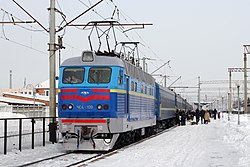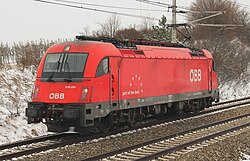Electric locomotive
An electric locomotive runs on electricity as the name suggests. Electric locomotives cost the least to buy and operate. However, the railway electrification system is very expensive, so only tracks used by many trains per day are usually electrified. Thus, electrics are only the second next used type, behind diesel locomotives.
Electric locomotives get their power from three main sources: overhead lines, an on-board battery, or a third rail.
There are many different types of electric locomotives. Battery-electric locomotives are powered by on-board batteries. They are used in situations where other types of engines could be dangerous.
Electric Locomotive Media
Škoda ChS4-109 with a Moscow–Odesa train in Vinnytsia railway station
The Siemens ES64U4 is the current confirmed holder as the fastest electric locomotive at 357 km/h (222 mph) in 2006.
A British Rail Class 91 at London King's Cross station.
EL-1 Electric locomotive of the Baltimore Belt Line, US 1895: The steam locomotive was not detached for passage through the tunnel. The overhead conductor was a ∩ section bar at the highest point in the roof, so a flexible, flat pantograph was used
A Milwaukee Road class ES-2, an example of a larger steeplecab switcher for an electrified heavy-duty railroad (DC) 1916
A Swiss Re 420 leads a freight train down the south side of the Gotthard line, which was electrified in 1922. The masts and lines of the catenary can be seen.










